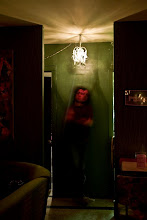In an apt confluence of agendas, MIA's new video is directed by relative unknown yet high concept video director Romaine Gavras. The video's explicit depiction of a US totalitarian regime huting down a very select minority group has garnered some controversy, but overall the video is not much more than a very clever narrative stunt.
M.I.A - BORN FREE VIDEO OFFICIAL (real and explicit version)
I say confluence because both artists work in a shady area of examining/critiquing/exploiting violence through commercial media. I'm not a big fan of MIA because I think her legitimately compelling backstory has unfortunately given her carte blanche to rant off shallow rebellion rhetoric and gun-fetish imagery to hungry white indie rock fans looking for ethnic authenticity and affirmation of their softball liberalism. Gavras could also potentially be accused of the same pandering, but the severity of his images and their specific locality gives his work more depth and insight.
Although not as well credited as he should have been, Gavras's work really came to public attention in 2008 after the release of his video for "Stress", by the electro-rock duo Justice:
justice stress (official video)
In it, a multicultural gang wearing Justice logo jackets go on a random crime spree in the streets of Paris. The cinema verite-style of the video forces the viewer to voyeuristically observe graphic scenes of muggings, fights, sexual harrassment and vandalism up close as it happens. It's an uncomfortable video to watch and the intention of it is not clear. Since it is still essentially a commercial to purchase products from Justice, are we celebrating the fictionalized gang as an counterpoint to Justice's musical domination in pop culture? Or is the music a springboard for Gavras to examine class "warfare" through the violent eyes of the culturally disenfranchised?
To make better sense of the Justice video, it's worthwhile to examine it within the context of Gavras's other work. A year before "Stress", Gavras directed a video by another Ed Banger Records artist, DJ Medhi:
SIGNATUNE (Dj Mehdi / T. Bangalter edit)
This video is more stylized than "Stress", with an ironic nod to Travolta's iconic apartment scenes in "Saturday Night Fever" and a general tone that both mocks and celebrates the testosterone-driven, self-actualization of tricked-out car culture. Nonetheless, there is an undercurrent of potential violence that rides underneath the carefully framed bleak, urban backdrops and closeups of working toughs. The implication is that these men choose cars over fists, but still maintain a firm gang identity. The storyline also builds up a rivalry between the protagonist and a competing car stereo enthusiast, with the competition being the only buffer between them and a physical altercation.
The last example is a video for "The Age of Understatement", by The Last Shadow Puppets; a side project featuring members of Artic Monkeys:
The Last Shadow Puppets - The Age of the Understatement
In the video, snowy images of the duo in a tank brigade are interspersed with shots of a young girl ice skating and a third, slightly surreal scene at what appears to be a Greek Orthodox church. The geographic location for all the action is an unnamed eastern European country that appears to have once been been ruled by the communist party. Gavras is metaphorically connecting the lyrics of flirtatious yet calculating young lovers to childhood innocence and the cultural weight of faded military prowness and religious orthodoxy. Despite such disparate sources, the video successfully holds it thematic images together into an implied, abstract exploration of loss and power.
I think the real trick in Gavras's work is that he infuses a socio-political narrative into music that usually does not have one, in essence adding layers of complexity by creative contrast. And until the MIA video, his thematic ideas seemed to have been specifically tied to historical and contemporary culture in Europe, as seen through the working class. Also of interest is that Gavras is the son of noted film director Costa Gavras. Gavras Sr. is known for his innovative, early use of handheld camerwork in feature films such as "Z" and for addressing issues of social injustice and political corruption. One could then argue that Romaine is continuing the work of his father in a modern context. Conversely, once cannot ignore the fact that Romaine's videos are still funded for the purpose of commerce and may ultimately be manipulating sensationalist imagery to sell products and brands. I would guess that he is acutely aware of this and perhaps encourages that skepticism as part of his creative agenda, but that idea in itself is a product of luxury, not politics.
Thursday, April 29, 2010
Subscribe to:
Post Comments (Atom)

1 comment:
Great post.
I'm all conflicted about MIA's new video, but I think I've decided that a little subtlety probably would have gone a long way on this one.
Post a Comment